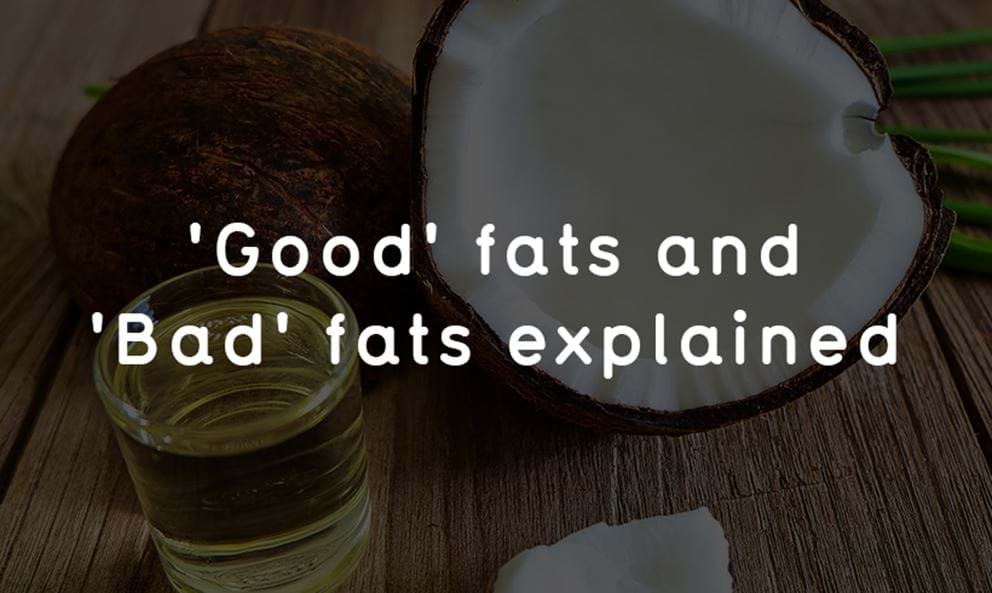Good fats and bad fats explained

It wasn’t so long ago that fat was the greatest enemy of the fitness magazines, pundits, and health aficionados of the world. Within recent memory, it was a common belief that even a touch too much fat in your diet spelt disaster.
More recently though, it’s become widely known that fat is actually an essential macro nutrient and plays a vital role in healthy hormone production.[1]
But are all fats created equal? Are some genuinely good and some genuinely bad? And just how much is “too much”?
Let’s take a look.
The (not-so) evil history of saturated fat
Dietary fats fall into three broad categories; unsaturated, saturated, and trans fats.
Saturated fat, found in meat, animal products, and certain vegetable products such as coconut oil, is a naturally occurring fat which remains solid at room temperature.
During the height of the anti-fat movement of past decades, saturated fat was typically seen as the big baddie – the thing which was bound to give you heart disease, cancer, and various other lethal ailments.
The initial fear of saturated fat was largely based on observational studies carried out in the 50’s, specifically Ancel Keys’ “Seven Countries Study”, in which diets high in saturated fat were correlated with populations at particular risk of heart disease.
Keys was convinced that saturated fat was behind heart disease. The lab research, on the other hand, doesn’t offer such a clear-cut picture. In fact, large numbers of studies find no such correlation between saturated fat intake and heart disease.[2]
To further complicate matters, a 2016 study from the University of Bergen found evidence that dietary intake of saturated fat might actually improve blood pressure, among other health variables, while at the same time not boosting the risk of heart disease.[3]
As the debate around saturated fat isn’t settled as of yet (there are some studies which do suggest a link to heart disease[4]), it’s generally advised that the majority of the fat in a person’s diet should be unsaturated.
The NHS suggests that the average man should eat only around 30g of saturated fat per day, while the average woman should eat only 20g per day.[5]
The clear benefits of unsaturated fats
While saturated fats may or may not deserve the bad reputation they’ve been shouldering for so long, the evidence is pretty conclusive when it comes to the health benefits of unsaturated fat (natural fat which remains liquid at room temperature, e.g. olive oil).
A 2016 Harvard study found that while mortality increased as saturated fat intake did (as compared to the same number of calories from carbs), it actually decreased – significantly – as unsaturated fat intake increased (again, compared to the same number of calories from carbs).
The decrease in overall mortality from a high unsaturated fat diet was striking, ranging from an 11% to a 19% lower overall risk, as compared to the carbs.[6]
Unsaturated fats are further divided between monounsaturated fat (e.g. olive oil), and polyunsaturated fat (e.g. fatty fish, vegetable oils).
Monounsaturated fats are generally stable when cooking at high temperatures, and research suggests they may have a variety of incredible health benefits – like helping to prevent coronary heart disease.[7]
Polyunsaturated fats divide into two sub-categories; omega 3 fatty acids and omega 6 fatty acids, and are more volatile and prone to damage and rancidity than monounsaturated fats (so less ideal for cooking with). Omega 3 fatty acids are known to reduce inflammation in the body and help with a wide range of health conditions, including diabetes.[8]
Omega 6 fatty acids are needed by the body too, but are typically over-abundant in modern Western diets due to a variety of factors (such as cattle being fed grain as opposed to grass). Evidence suggests that having too many omega 6 fatty acids in your diet can cause inflammation in the body[9], so it’s important to focus on getting sufficient omega 3’s in to even out the ratio.[10]
Unlike with other macronutrient types, overall fat intake is generally not covered in national dietary guidelines. The key is in not exceeding the suggestions for saturated fat intake, and in using unsaturated fats for the majority of your fat intake.
One of the great nightmares that arose from the processed food industry, and the anti-saturated-fat terror of recent times, was the promotion of trans fats in products such as margarine, sold as a healthy plant-based alternative.
The problem, of course, is that trans fats turned out to be super bad.
The trans fats found in processed foodstuffs are created artificially by adding hydrogen to unsaturated fats, causing them to act more like saturated fats in some ways and take on a variety of new attributes. Because of this process, trans fats may also be referred to as “hydrogenated fats”, “partially hydrogenated fats”, “hydrogenated oils”, etc.
An almost endless array of studies show that trans fats harm the health and proper functioning of the body, ranging from promoting inflammation and damaging cell function[11], to lowering good (HDL) cholesterol in the body and damaging arteries[12], to promoting obesity[13] and more.
One study even found that simply replacing trans fats with other types of fat could potentially reduce heart disease risk by as much as 40%[14].
The verdict is clear on trans fats – avoid them.
[1] https://www.ncbi.nlm.nih.gov/pubmed/6298507
[2] https://www.ncbi.nlm.nih.gov/pmc/articles/PMC2824152/
[3] https://www.sciencedaily.com/releases/2016/12/161202094340.htm
[4] https://www.ncbi.nlm.nih.gov/pubmedhealth/behindtheheadlines/news/2016-07-06-study-finds-link-between-saturated-fats-and-early-death/
[5] http://www.nhs.uk/Livewell/Goodfood/Pages/Eat-less-saturated-fat.aspx
[6] https://www.hsph.harvard.edu/news/press-releases/higher-consumption-of-unsaturated-fats-linked-with-lower-mortality/
[7] https://www.ncbi.nlm.nih.gov/pmc/articles/PMC4879159/
[8] https://www.ncbi.nlm.nih.gov/pubmed/26829184
[9] https://www.ncbi.nlm.nih.gov/pubmed/24945416
[10] https://www.ncbi.nlm.nih.gov/pubmed/17045070
[11] https://www.ncbi.nlm.nih.gov/pubmed/22216328
[12] https://www.ncbi.nlm.nih.gov/pubmed/11451757
[13] https://www.ncbi.nlm.nih.gov/pubmed/17636085
[14] http://www.nature.com/ejcn/journal/v63/n2s/full/1602976a.html


